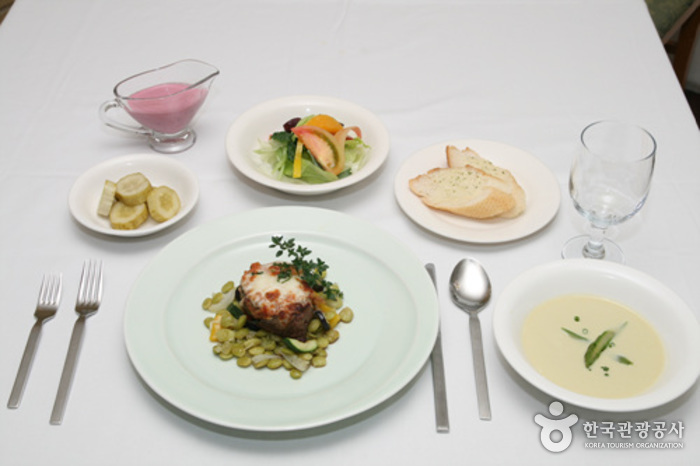Lotte Outlets - Daegu Yulha Branch [Tax Refund Shop] (롯데아울렛 대구율하점)
12.4Km 2024-04-23
80, Ansim-ro, Dong-gu, Daegu
-
The North Face - Lotte Yulha Branch [Tax Refund Shop] (노스페이스 롯데율하)
12.4Km 2024-04-23
80, Ansim-ro, Dong-gu, Daegu
-
Yuksinsa Shrine (육신사)
12.6Km 2024-02-15
64 Yuksinsa-gil, Habin-myeon, Dalseong-gun, Daegu
Yuksinsa Shrine is a revered site dedicated to honoring the Sayuksin. Established during the Joseon dynasty, it stands well-preserved to this day. "Sayuksin" translates to "six dead ministers," referencing the six loyal subjects who, in 1453, attempted to restore King Danjong of the Joseon dynasty but were ultimately captured and executed. The shrine's entrance, marked by the Chungjeolmun Gate, is flanked by long rows of crape myrtle trees. These trees create a stunning visual spectacle when their red flowers are in bloom.
Daegu Art Museum (대구미술관)
12.6Km 2025-01-13
40, Misulgwan-ro, Suseong-gu, Daegu
+82-53-803-7900
Daegu Art Museum is a municipal museum supported by the Daegu Municipal Government. The museum holds exhibitions to promote Daegu's art advancement through the study of the art's historical value. The museum also has planned exhibitions introducing the social and artistic issues of the times and the leading trends in the art scene through domestic and overseas exchanges.
Diverse performances and events such as academic programs and lectures with famous professors are offered to children, teens and citizens of all ages. The Art Information Center on the third floor within the museum library is where visitors can read art-related books or rest at the lounge.
Grand opening: May 26, 2011
Pyeonggwang-dong Apple Village (평광동 사과마을)
12.9Km 2023-11-09
37 Dopyeong-ro 116-gil, Dong-gu, Daegu
Pyeonggwang-dong Apple Village is home to some 140 apple orchards. The village is located at the foot of Palgongsan Mountain, and has been growing apples for over 100 years, even creating a new apple, the Pyeonggwang honey apple. The village features many impressive trees, including the nation's oldest Hongok apple tree, a pine tree planted in honor of Korean Independence, and a large willow tree referred to as Filial Soon Gang Sunhang Tree. Many families visit in fall the enjoy apple picking.
Gooam Farmstay Village (구암팜스테이마을)
13.1Km 2024-03-15
8-1 Guam-gil, Dong-gu, Daegu
+82-53-984-5273
Known as "Gooam" due to its rock formations resembling turtle's shell, Gooam Farmstay Village offers various activities such as harvesting agricultural produce, traditional food making, traditional games, and craft experiences. Depending on the season, there are experiences like picking strawberries, digging potatoes, picking cherry tomatoes, gathering chestnuts, and harvesting persimmons. Visitors can also participate in making bean curd, rice cakes, kimchi, catching loaches, making kite, and experiencing hanji crafts.
Daegu Spa Valley (대구 스파밸리)
13.3Km 2025-08-12
891 Gachang-ro, Gachang-myeon, Dalseong-gun, Daegu
+82-1688-8511
Daegu Spa Valley is a year-round water park offering various water attractions and hot springs. It features a 250m lazy river pool, Speed Slides, Jungle Aqua, hot spring saunas, Aqua Play, and both indoor and outdoor water playgrounds. There are water park experience programs available for day trips or overnight stays.
Blue Moon Restaurant (블루문)
13.5Km 2020-04-30
685, Pagye-ro, Dong-gu, Daegu
+82-53-981-8088
Located at the foot of Palgongsan Mountain, Blue Moon is a great place to enjoy authentic steaks and fusion dishes. Take a stroll in the nearby park and watch the water fountain next to the walking trail. The restaurant has four floors, each with a different atmosphere to suit any occasion.
Daegu Stadium (대구스타디움)
13.7Km 2022-06-30
180, Universiad-ro, Suseong-gu, Daegu
+82-53-803-8300
Daegu Stadium is a sports stadium located in Daeheung-dong, Suseong-gu in Daegu. Construction of the stadium began on July 28, 1997 and was completed on May 20, 2001. Its roof is designed to resemble a globe, incorporating the beautiful curves found in the roofs of traditional Korean houses.
The stadium seats approximately 66,000 people and is suitable for hosting large-scale international sports games and 74% of the seats are protected by a Teflon-coated overhang. The 47,407 square meter stadium has three stories below ground and three above ground floors and is built on a 512,479 square meters of land just 9 kilometers southeast of the city’s downtown area.
Stadium facilities include a gymnasium, baseball field, indoor ice rink, horseback riding track, tennis court, fitness center, shooting range, archery range, skateboard park, and an indoor jogging course. There are smaller buildings for taekwondo, judo, and rock climbing.
Daegu Stadium has hosted a number of 2002 FIFA World Cup matches; Senegal vs. Denmark (June 6), Slovenia vs. South Africa (June 8), Korea vs. U.S.A. (June 10) and Korea vs. Republic of Turkiye (June 29).
Olive Young - Daegu Siji Branch [Tax Refund Shop] (올리브영 대구시지)
14.6Km 2024-04-18
3214, Dalgubeol-daero, Suseong-gu, Daegu
-
![Lotte Outlets - Daegu Yulha Branch [Tax Refund Shop] (롯데아울렛 대구율하점)](http://tong.visitkorea.or.kr/cms/resource/35/2883835_image2_1.jpg)


![Olive Young - Daegu Siji Branch [Tax Refund Shop] (올리브영 대구시지)](http://tong.visitkorea.or.kr/cms/resource/51/2884151_image2_1.jpg)
 English
English
 한국어
한국어 日本語
日本語 中文(简体)
中文(简体) Deutsch
Deutsch Français
Français Español
Español Русский
Русский